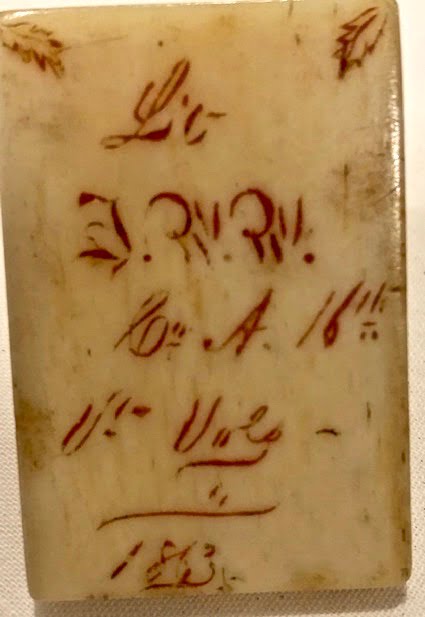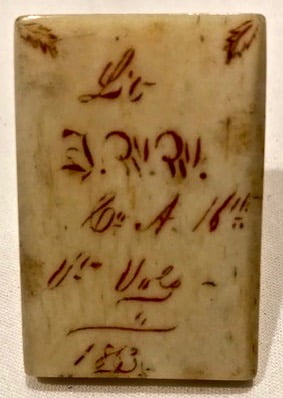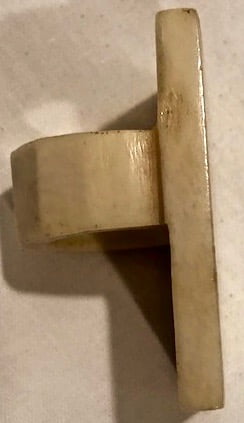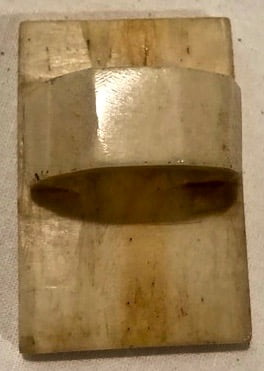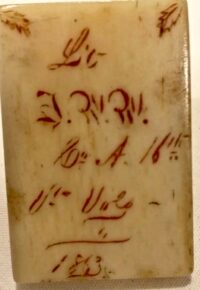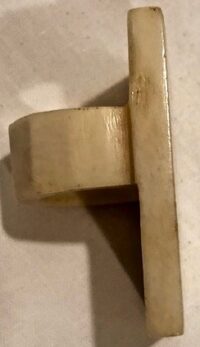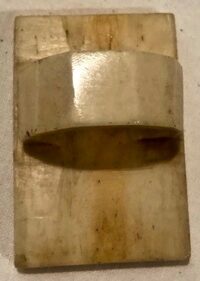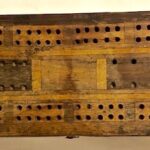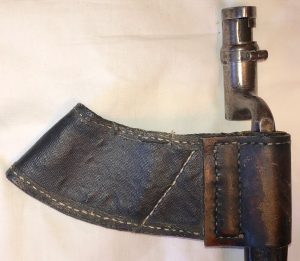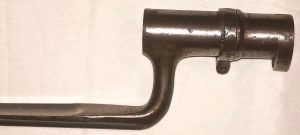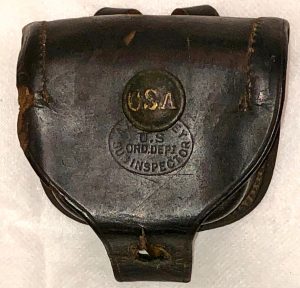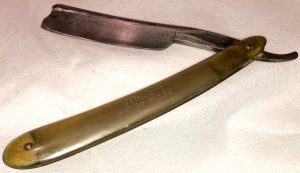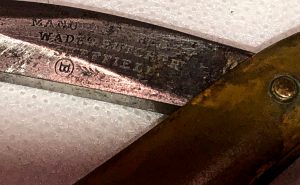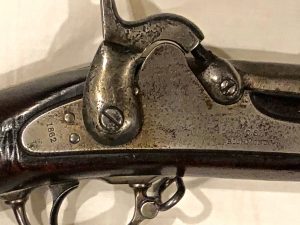Id’d Civil War Hand Carved Bone Neckerchief Slide
Id’d Civil War Hand Carved Bone Neckerchief Slide – This nicely detailed bone neckerchief slide was expertly carved and etched by Lt. Joseph W. Waldo of Company A, 16th Vermont Infantry. Waldo skillfully etched his rank, initials, company, regiment and the date, 1863, into the face of the slide, then filled in the etchings with a red paraffin wax. The slide was carved in one piece, seemingly from cow bone and remains in excellent shape, with no cracks. Measurements: Height (of face) – 1.75”; Width (of face) – 1.25”.
Joseph W. Waldo
| Residence Royalton VT; Enlisted on 8/26/1862 as a 2nd Lieutenant. On 10/12/1862 he was commissioned into “A” Co. VT 16th Infantry He Resigned on 3/12/1863 |
16th VT Infantry
(9-mos )
| Organized: Brattleboro, VT on 10/23/62 Mustered Out: 8/10/63 at Brattleboro, VTOfficers Killed or Mortally Wounded: 1 Officers Died of Disease, Accidents, etc.: 1 Enlisted Men Killed or Mortally Wounded: 23 Enlisted Men Died of Disease, Accidents, etc.: 48 (Source: Fox, Regimental Losses) |
| From | To | Brigade | Division | Corps | Army | Comment |
| Oct ’62 | Feb ’63 | 2 | Casey’s | Military District of Washington | New Organization | |
| Feb ’63 | Apr ’63 | 2 | Casey’s | 22 | Department of Washington, D.C. | |
| Apr ’63 | Jun ’63 | 2 | Abercrombie’s | 22 | Department of Washington, D.C. | |
| Jun ’63 | Aug ’63 | 3 | 3 | 1 | Army of Potomac | Mustered Out |
VERMONT
SIXTEENTH REGIMENT.
(NINE MONTHS.)
| BY CORPORAL CHANDLER M. RUSSELL, COMPANY F, And SERGEANT LYMAN S. EMERY, COMPANY A SIXTEENTH REGIMENT. THE Sixteenth regiment of Vermont Volunteers was composed of companies which were recruited in the counties of Windsor and Windham. These companies met and organized at their respective places of rendezvous between the dates of August 26 and September 20, 1862, as follows: Company A–at Bethel; Henry A. Eaton, Captain. Company B–at Brattleboro; Robert B. Arms, Captain. Company C–at Ludlow; Asa G. Foster, Captain. Company D–at Townshend; David Ball, Captain. Company E–at Springfield; Alvin C. Mason, Captain. Company F–at Wilmington; Henry F. Dix, Captain. Company G–at Barnard; Harvey N. Bruce, Captain. Company H–at Felchville; Joseph C. Sawyer, Captain. Company I–at Williamsville; Lyman E. Knapp, Captain. Company K–at Chester; Samuel Hutchinson, Captain. On the 27th of September, 1862, the officers of these companies met at Bellows Falls and elected the field officers of the regiment, as follows: Wheelock G. Veazey of Springfield, Colonel; Charles Cummings of Brattleboro, Lieutenant-Colonel; William Rounds of Chester, Major; Jabez D. Bridgman of Rockingham, Adjutant; James G. Henry of Royalton, Quartermaster; Dr. Castanus B. Park, Jr., of Grafton, Surgeon; Dr. George Spafford of Windham, Assistant Surgeon; Rev. Alonzo Webster of Windsor, Chaplain. This regiment rendezvoused at Brattleboro on the 9th of October, 1862, and was mustered into the United States service on the 23d of October, 1862, by Major William Austine, with 949 officers and men, and a more intelligent and educated body of men, it is safe to say, was never mustered for any regiment. The regiment left Brattleboro for the seat of war on the 24th of October, 1862, by way of New Haven Connecticut, over the Sound Line of Steamers to New York, thence to Port Monmouth by boat, and then by rail the balance of the way to Washington, where it arrived on the morning of October 27. It went into camp on Capitol Hill near where the Twelfth, Thirteenth, Fourteenth and Fifteenth regiments, which had just preceded it, were in camp, and with which it was brigaded, forming what was known as the Second Vermont Brigade. On the 30th of October the regiment moved across the Potomac River and encamped with the rest of the brigade near Ball’s Cross Roads in Virginia. This place was called “Camp Seward.” The regiment remained at this camp until November 3, when it moved to a high ridge overlooking the Potomac River and near Hunting Creek, a distance of about nine miles. The whole brigade moved at the same time to the same place, and from that time on the place was called Camp Vermont. It was expected that the regiment would remain at this place during the winter as a part of the reserve force for the defense of Washington, and considerable pains were taken to stockade and make camp life comfortable, but on the 11th of December the brigade was ordered to move, and on the following day did move out farther to the front. The first night it encamped at Fairfax Court House and the next day moved on to a point near Centreville, where it remained, doing picket duty for several days, and then returned to Fairfax Court House and remained there until January 20, 1863. The regiment then moved to Fairfax Station on the Orange and Alexandria railroad and remained there until the 24th of March, and then moved down the railroad about six miles on a high point near Union Mills. The principal service while here was picket duty on Bull Run, and at points farther down the railroad, which was being repaired and opened for transportation to the Rappahannock River. May 27 the regiment was ordered to guard the railroad, and companies A and G, in command of Captain Eaton, were stationed at Manassas Junction, and companies C, D, E and F, with Colonel Veazey and Major Rounds, were stationed at Bristoe Station, near Broad River, and companies B, I and K, with Lieutenant-Colonel Cummings in command, were stationed at Catlett’s Station. May 30 a supply train was attacked by a party of raiders under Mosby and considerable damage done. A short skirmish occurred and the raiders were driven back. On the 11th of June the regiment returned to Union Mills and resumed picket duty along Bull Run. On the 23d the brigade, which had been commanded since April 20 by General Stannard, became attached to the First Corps of the Army of the Potomac under General Reynolds. The Confederates had already started on their raid toward Pennsylvania and a heavy battle was imminent. On the 25th orders came to move and the pickets on duty were called in. Colonel Veazey called his officers and non-commissioned officers together and assured them that they might soon expect to meet the enemy in battle, and gave them good advice and instructions. At 3 o’clock of that day, the regiment started on its march, joining the great tide of the Army of the Potomac, which was moving northward to intercept the enemy in its advance on Washington, Baltimore, Harrisburg and Philadelphia. The Potomac was crossed at Edward’s Ferry and the great army passed on through Adamstown, Frederick, Jeffersonville and other towns. On the 30th, after a forced march of six days in heavy marching order, the regiment reached Emmettsburg, and a rest was taken there for the night. About ten o’clock the next morning the sound of battle was heard in the direction of Gettysburg, and the regiment moved on at noon in that direction as rapidly as possible. The weather was intensely hot, the men were weary and foot-sore, but every man readily and quickly fell into line. The usual hilarity of a start did not prevail, but instead each man’s face bore a grave, determined look. At 5 o’clock the regiment was in full view of the terrible scene. Shells bursting in the air, smoke of burning buildings, the roar of artillery, wounded men being borne to the rear, citizens of the town and vicinity fleeing for their lives, cast a gloom over the men, but the ranks gathered up closer and the sturdy men commenced nerving themselves for the emergency. As the regiment neared the attlefield, a halt was made, the guns and ammunition were inspected, bayonets fixed, and the regiment started at a rapid pace, sometimes at double-quick, and soon formed in the battle line upon the ridge, a little to the left of Cemetery Hill. The first day’s fight was just over, and our troops had been forced back through the town upon this ridge and hill. About one-third of the Sixteenth regiment, under command of Major Rounds, was detailed for picket duty that night, and the remainder took position on the rear slope of Cemetery Hill and bivouacked for the night, which all with reason apprehended would be the last night on earth of more or less of our number. In the morning, July 2, the pickets were recalled, but during the forenoon, company B, Captain Arms, was sent forward to re-enforce the skirmish line, and there rendered splendid service. This company was taken into position by Captain Foster of company C, who was then on General Stannard’s staff, and was wounded in discharging this duty. The main battles of July 2 were fought on the right and left flanks of the Union line. Near the close of the battle on the left, which had been fought with the greatest severity and had finally involved several Corps of the Union Army, the Sixteenth, with the rest of the brigade, was moved about one-half mile to the left along Cemetery Ridge to re-enforce our badly shattered lines. In this movement it was under terrific artillery fire, one shell hitting two men and killing them instantly. The regiment was finally halted in support of a battery and just in season to receive and repel a heavy charge of infantry. Darkness soon came on and the battle ceased with the Sixteenth in the front line. Soon after this Colonel Veazey was detailed to take the regiment with others and establish a picket line across the battlefield of that afternoon. The battle had been fought back and forth over this ground and it was literally covered with dead and wounded men, among whom the Sixteenth were deployed to watch the enemy while our army was resting for a renewal of the awful conflict in the morning. No regiment ever had a more trying night on picket duty. It was not relieved in the morning, but the men held the same position as skirmishers throughout the forenoon and until the final assault. The position of the reserves, supporting the skirmish line, was twenty rods or more in advance of the main line of battle, and the skirmish line was considerably in advance of the reserves and extended a long distance to the right and left. The famous infantry charge of July 3 was preceded for two hours by the great artillery duel, participated in by some 250 guns, the regiment being in the depression between the two lines of cannon. This was followed by the charge of Longstreet’s three divisions, Pickett’s leading the same and striking first the skirmish line of the Sixteenth regiment. Pursuant to previous orders of our colonel, the skirmishers rallied on the reserves, except company G, which was so far to the right that it was obliged to retire to the main line of battle in another direction, where it opportunely met company B, which had not rejoined the regiment after it was detached the day before, as above explained, and these two companies under Captain Arms took position in support of a battery and there fought valiantly through the battle. There were, therefore, but eight companies occupying the advanced position of the reserves and towards which Pickett’s division of the enemy seemed to be directed, but as they were approaching within rifle range the enemy changed its direction to its left and sufficiently to uncover our direct front and began to pass by our right flank. Our colonel then moved us to the right and changed our front so as to be at right angles with the main line, and we assaulted Pickett’s right flank. During this movement we fired directly into the rebel flank and advanced a distance to the right of about a thousand yards, and continued the charge until Pickett’s division had mainly disappeared, a great proportion being killed, wounded or captured. At this moment, another rebel line appeared off to our left and was apparently aiming in the direction of the position we held before making this charge to the right. This new force turned out to be Perry’s and Wilcox’s brigades. Colonel Veazey immediately got the regiment into line, began a movement back over the same ground we had just passed, and again changed our front so as to be again at right angles with the main line of battle, but facing to the left instead of the right, and just as those two brigades reached the point from which we had started he ordered us to charge their flank, which we did with a cheer and followed it a long distance until that line had wholly disappeared, and this was the end of the battle of Gettysburg, with our regiment still holding its original extreme advanced position, having captured prisoners many times its own number and three stands of colors. The regiment suffered considerable loss in killed and wounded, but much less than would be expected from its participation at the pivotal point of the battle far in advance of any other troops of the Union line, and where the collision of the fighting was probably as severe and stubborn as ever occurred in battle; but the comparatively small loss under the circumstances was due to the fact that the regiment was constantly on the move in charging flanks to the right and left and so was not exposed to the direct front fire of the enemy’s infantry lines. The conspicuous part it took in this great battle, its size and bearing in the conflict at a trying and critical period, its skillful management by Colonel Veazey, won for it and its gallant and much beloved commander a conspicuous place in the annals of the war. After the battle, Colonel Veazey being put in command of the brigade, it joined in the pursuit of Lee’s forces until they had crossed the Potomac back into Virginia, and then, as the term of enlistment of the regiment had expired, it started toward home, arriving in New York City when the draft riot was at white heat, and it volunteered to remain there until order was restored. It camped upon the Battery, lying upon its arms and ready for any emergency. No disturbance, however, called it into action. From there it returned to Brattleboro, Vermont, and was mustered out August 10, 1863, with 831 officers and men. The history of this regiment would hardly be complete without a brief reference to its commander. Col. Wheelock G. Veazey was born at Brentwood, New Hampshire, December 5, 1835. He graduated at Dartmouth College, and later at the Albany Law School, and had just commenced the practice of law at Springfield, Vermont, when the war commenced. He enlisted early in the war as a private in the Third Vermont regiment, was made captain of company A of that regiment, and soon promoted to Major and Lieutenant-Colonel. He was in the Peninsular Campaign under General McClellan, and participated in the many battles of that campaign. For a while he was on the staff of Gen. W. F. Smith, better known as Gen. “Baldy” Smith. The Sixteenth regiment was therefore fortunate in having as its commanding officer one whose experience in the field had equipped him so thoroughly for this command. He succeeded well in winning the confidence of the officers and men and to an eminent degree won their universal love and respect. After the war Colonel Veazey served conspicuously as lawyer, legislator, supreme court judge, and in many other positions of public trust, and resigned his office as Judge to accept an appointment by President Harrison as Interstate Commerce Commissioner, which position he now holds. The veteran soldiers have honored him in many ways, and especially when the great order of the Grand Army of the Republic elected him Commander in Chief at Boston in 1890. His administration in that capacity was signally able and successful, and marked an era of prosperity in that noble order. ENGAGEMENTS. Burke’s Station, Va., (Repulse of Stuart’s Raid), Dec. 28, 1862. Catlett’s Station, Va., May 30, 1863. Gettysburg, Pa., July 1, 2 and 3, 1863. |
